-

Win a Free Custom Engraved Brass Coin!!!
As a way to introduce our brass coins to the community, we will raffle off a free coin during the month of August. Follow link ABOVE for instructions for entering.
You are using an out of date browser. It may not display this or other websites correctly.
You should upgrade or use an alternative browser.
You should upgrade or use an alternative browser.
VOC SPIEGELRETOURSCHIP BATAVIA 1628 - KOLDERSTOK 1:72
- Thread starter Heinrich
- Start date
- Watchers 64
-
- Tags
- batavia kolderstok
- Joined
- Jan 9, 2020
- Messages
- 10,534
- Points
- 938

Thank you my friend. I am trying.Heinrich, beside my Cardinal Joke, I have to tell you that the ship is looking better and better every day. Nice job !!! Well done !!!
Daniel
Ach, so!@Vfordyce
@Dematosdg
OK Gents, Thanks to @janzwart Jan, I have your answer. Those were openings through which rope could be fed when towing the chaloup (sloop/lifeboat).
View attachment 262519
Here they are on the real ship.
View attachment 262520
And in action.
Hello Heinrich!
What a beautiful ship you have. I noticed the very similar design to my Vasa and (after comparative research) no wonder. The Vasa was designed by a Dutch born mastership builder Henrik Hybertsson. How interesting. The picture in your post # 1100 is amazing. This must be a replica of early 17th century Dutch ships as I thought the Vasa was unique as being the only surviving original ship from so long ago?
What a beautiful ship you have. I noticed the very similar design to my Vasa and (after comparative research) no wonder. The Vasa was designed by a Dutch born mastership builder Henrik Hybertsson. How interesting. The picture in your post # 1100 is amazing. This must be a replica of early 17th century Dutch ships as I thought the Vasa was unique as being the only surviving original ship from so long ago?
Heinrich, thank you for this nice comment on the new model we are making. Maybe you have noticed on the Dutch forum that I did not post new photos since the 26th of september. I was busy preparing my models for the exhibition on the 2nd of october, and after that busy with finishing the model of the Fluyt. I will try to post a more recent photo in this topic within the next days. I am pretty pleased with it myself - to be honestOne of the most fascinating builds I have followed in a long time is the development build of Kolderstok's new model - a Dutch Fluit. Hans from Kolderstok has already completed a prototype up to the point where he is busy with the rigging, while one of the senior builders on Modelbouwforum, Hans Groenenberg, is doing a "kit test-build".

This picture shows Hans Groenenberg's build from the top. How is that for a planking challenge guys? !!! Bear in mind that it is single-planking. The model will probably carry a difficulty rating higher than even that of the Zeven Provincien, so you can only stand in awe of the result above. And just look at that incredible weathering effect - weathered without looking neglected or sloppy.
- Joined
- Jan 9, 2020
- Messages
- 10,534
- Points
- 938

Thank you for the very kind words Daniel. It is indeed a replica of the Batavia - Lelystadt in the Netherlands plays homeport to it.Hello Heinrich!
What a beautiful ship you have. I noticed the very similar design to my Vasa and (after comparative research) no wonder. The Vasa was designed by a Dutch born mastership builder Henrik Hybertsson. How interesting. The picture in your post # 1100 is amazing. This must be a replica of early 17th century Dutch ships as I thought the Vasa was unique as being the only surviving original ship from so long ago?
- Joined
- Jan 9, 2020
- Messages
- 10,534
- Points
- 938

@Kolderstok It is a pleasure Hans. The fact that you are considering different options and configurations of the ship (e.g. whaler and wood carrier) would be a great idea.
Just my opinion... for what it is worth. I think these are nice ships with a lot of potential, but I would prefer to see carvings or ornamentation with more definition. This is a crucial area of all ship builds. The best planked ship only looks as good as the pieces glued to it! So a step in the direction of either CNC carved or resin printed ships decorations, would be a vast improvement in the overall presentation!@Kolderstok It is a pleasure Hans. The fact that you are considering different options and configurations of the ship (e.g. whaler and wood carrier) would be a great idea.
It's interesting that the rudder doesn't go all the way up into the ship. I wonder how it's steered.@Vfordyce
@Dematosdg
OK Gents, Thanks to @janzwart Jan, I have your answer. Those were openings through which rope could be fed when towing the chaloup (sloop/lifeboat).
View attachment 262519
Here they are on the real ship.
View attachment 262520
And in action.
I’m referring to the picture of the actual ship.@Vfordyce That's an easy answer Vic - I have yet to install the rudder!
- Joined
- Jan 9, 2020
- Messages
- 10,534
- Points
- 938

@Vfordyce The 17th Century Dutch ships were steered with a whipstaff or "Kolderstok" in Dutch. (That is actually where Kolderstok Models derived its name from).

Here the Kolderstok is the wooden piece at the top of the rudder. @pietsan (Piet Sanders - Willem Barentsz)
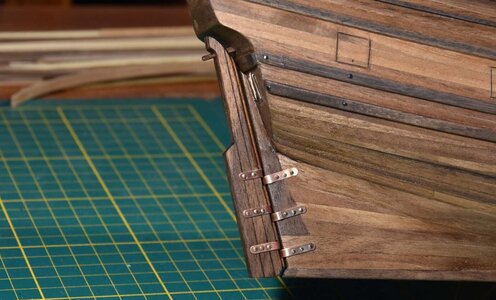
And the rudder with kolderstok mounted on the ship. As the actual whipstaff is not operational on the model, only part of it is simulated to create the correct effect.
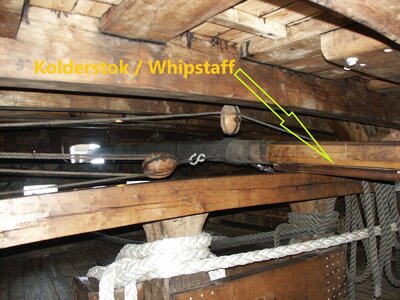
On the real ship the kolderstok is a substantial wooden beam which is operated by means of blocks, tackles and the like. The end extends into the "stuurplecht" or steering deck from where the helmsman steers.
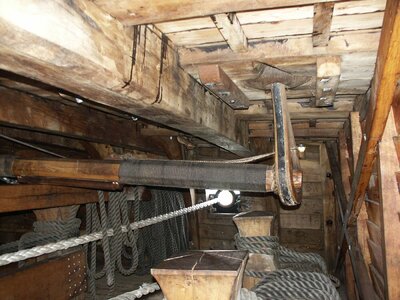
Here you can see the whipstaff as it extends through the steering deck directly above it.
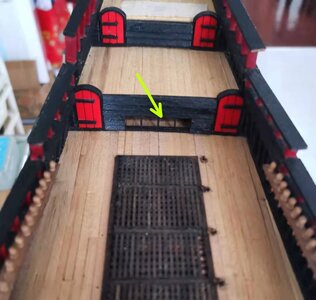
This picture shows the "stuurplecht" or steering deck (with "windows" from where the helmsman steered the ship.
I hope this makes sense!

Here the Kolderstok is the wooden piece at the top of the rudder. @pietsan (Piet Sanders - Willem Barentsz)

And the rudder with kolderstok mounted on the ship. As the actual whipstaff is not operational on the model, only part of it is simulated to create the correct effect.

On the real ship the kolderstok is a substantial wooden beam which is operated by means of blocks, tackles and the like. The end extends into the "stuurplecht" or steering deck from where the helmsman steers.

Here you can see the whipstaff as it extends through the steering deck directly above it.

This picture shows the "stuurplecht" or steering deck (with "windows" from where the helmsman steered the ship.
I hope this makes sense!
- Joined
- Jan 9, 2020
- Messages
- 10,534
- Points
- 938

Thank you for your comments Dean. As always they are valued and taken to heart. I think that each model manufacturer has its strengths and weaknesses. I also believe that @Kolderstok Hans is fully aware that this is one area in which his models can be improved. The Fluit which will be his latest model, will see the introduction of 3D printed ornamentation for the first time.Just my opinion... for what it is worth. I think these are nice ships with a lot of potential, but I would prefer to see carvings or ornamentation with more definition. This is a crucial area of all ship builds. The best planked ship only looks as good as the pieces glued to it! So a step in the direction of either CNC carved or resin printed ships decorations, would be a vast improvement in the overall presentation!
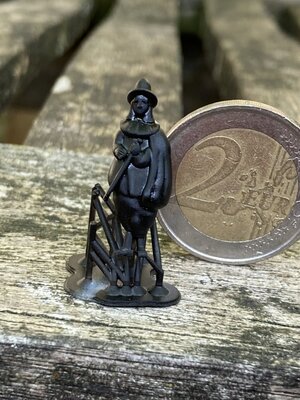
Also, bear in mind that my painting and finishing skills are non-existent. If the ornamentation had been finished by you or @dockattner Paul or any of the much more accomplished builders out here, it would also look 100% more realistic than in my hands.
My reference to the planking refers to the hull shape of the Fluit which is truly the most complex that I have seen on any ship.
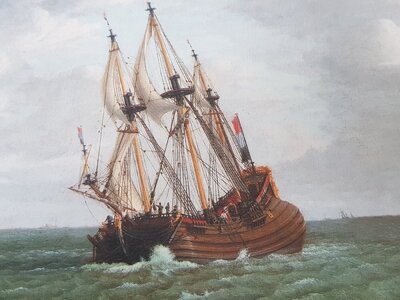
To me the envisaged appeal of building this model would stem from the fact that I have planked a hull (hypothetically-speaking) which is easily considered as the most difficult one to plank - even more so in single-planking configuration.
Good to know they are moving towards better quality. A lot of kits on the market have horrible quality castings or moldings of decorations, plastic or metal. That’s one area kits need improvement by all manufacturers IMO. One reason I am learning to carve.Thank you for your comments Dean. As always they are valued and taken to heart. I think that each model manufacturer has its strengths and weaknesses. I also believe that @Kolderstok Hans is fully aware that this is one area in which his models can be improved. The Fluit which will be his latest model, will see the introduction of 3D printed ornamentation for the first time.
View attachment 262603
Also, bear in mind that my painting and finishing skills are non-existent. If the ornamentation had been finished by you or @dockattner Paul or any of the much more accomplished builders out here, it would also look 100% more realistic than in my hands.
My reference to the planking refers to the hull shape of the Fluit which is truly the most complex that I have seen on any ship.
View attachment 262604
To me the envisaged appeal of building this model would stem from the fact that I have planked a hull (hypothetically-speaking) which is easily considered as the most difficult one to plank - even more so in single-planking configuration.
I see now. Much clearer.@Vfordyce The 17th Century Dutch ships were steered with a whipstaff or "Kolderstok" in Dutch. (That is actually where Kolderstok Models derived its name from).
View attachment 262598
Here the Kolderstok is the wooden piece at the top of the rudder. @pietsan (Piet Sanders - Willem Barentsz)
View attachment 262599
And the rudder with kolderstok mounted on the ship. As the actual whipstaff is not operational on the model, only part of it is simulated to create the correct effect.
View attachment 262600
On the real ship the kolderstok is a substantial wooden beam which is operated by means of blocks, tackles and the like. The end extends into the "stuurplecht" or steering deck from where the helmsman steers.
View attachment 262601
Here you can see the whipstaff as it extends through the steering deck directly above it.
View attachment 262602
This picture shows the "stuurplecht" or steering deck (with "windows" from where the helmsman steered the ship.
I hope this makes sense!
- Joined
- Jul 9, 2019
- Messages
- 497
- Points
- 323

Very stoked to see this. I have been eying Sergal's Dutch Whaler (Balaniera Olandese) as a substitute of sorts, but I think I will hold out for this Kolderstok Fluit kit.a Dutch Fluit. Hans from Kolderstok has already completed a prototype up to the point where he is busy with the rigging, while one of the senior builders on Modelbouwforum, Hans Groenenberg, is doing a "kit test-build".
Cheers!
- Joined
- Jan 9, 2020
- Messages
- 10,534
- Points
- 938

@Brewbrarian Great stuff Eric! I do not want to steal Hans's thunder, but I can tell you from what I have seen, that it will be an amazing build. He plans to have everything ready by the end of the year so let's hold thumbs!
Thank you for this very kind and generous comment Heinrich. I still have a lot to learn (understatement!) but I am greatly enjoying this new hobby and your encouraging words add to that.Also, bear in mind that my painting and finishing skills are non-existent. If the ornamentation had been finished by you or @dockattner Paul or any of the much more accomplished builders out here, it would also look 100% more realistic than in my hands.



